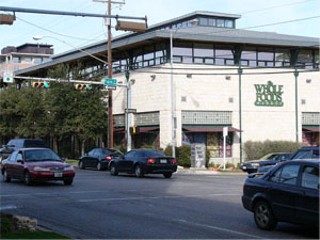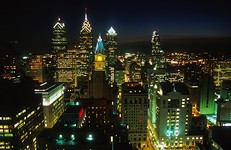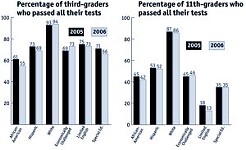Weird by Design
City's proposed design standards emphasize livability, walkability, and flexibility
By Rachel Proctor May, Fri., April 1, 2005

In much of Austin, suggesting that our fair city leaves anything at all to be desired is akin to saying that a certain Nazarean carpenter didn't walk on water. Our weirdness is legendary. Our funk is indisputable. Few and lonely are those who deny Austin's rightful place as the coolest town in ... let's just say the entire known universe.
Equally few, however, would suggest it's the prettiest.
Austinite Bethany Wofford, for example, has loved Austin since her parents drove her up from San Antonio to visit her grandparents on the weekends. She loves Town Lake and Zilker Park, loves strolling the tree-lined streets of Hyde Park. But outside of the green spaces and a few nice neighborhoods, Wofford will admit that much of her beloved hometown – and especially the places she does her shopping – is really rather unsightly. "I just ignore that part," she said. "I guess I just have a small geographic area that I consider 'Austin.'"
"A lot of parts of Austin are ugly. It's the people that make it special," seconds Joe England, a Dallas native who's lived in Austin since 1976. Council Member Brewster McCracken agrees. Publicly, even. He's willing to argue that Austin's islands of breathtaking beauty are floating in a blighted concrete sea. More and more of Austin, he says, looks like Anywhere, USA, with national chain retailers doing business out of big-box outposts, cluttering up the landscape with big, ugly signs. But he also believes we can do something about it. His answer is to give Austin's commercial strips a slow, gradual face-lift by enacting a set of design standards for all new commercial construction in Austin. The final recommendations will be ready for public hearing at the City Council meeting on April 14; if adopted, the ordinances would nudge Austin toward a day when even chain restaurants with billions and billions served will design buildings that are a little bit weird.
"We don't want Austin to look like every other city in America," said McCracken. "We're trying to encourage design that reflects the character of Austin, without telling people what that character is."
But the issue of "design" is about more than just lookin' purty. While some aspects of the proposed ordinance are strictly for show, such as rules discouraging national chains' highway mega-signs, this is not about imposing an official "look" ã la Santa Fe, which requires certain buildings to be made of adobe. Instead, its core provisions govern land use and development orientation (i.e., where the building is in relation to the street and the parking lot) with the goal of creating walkable, human-scale streetscapes. Taking this broad approach to design, says Laura Morrison of Austin Neighborhoods Council, elevates the standards beyond simple notions of a style police. "I'm pleased that the primary focus is not on aesthetics of buildings, which I think shouldn't be regulated, but functionality and configuration of the built environment," said Morrison.

The standards would apply only to new commercial developments – existing buildings and residential areas are exempt. While the standards contain some dictates – increased vegetation is mandated; blank concrete facades are banned – in general the ordinance aims to achieve its goal through an elaborate system of incentives and disincentives. The most desirable features, such as planting trees or building vertical mixed-use projects, would enjoy streamlined permitting or fee reductions, while less desirable ones, like big boxes, would endure the regulatory hurdles. Over time, as spiffy new developments replace poorly designed older ones, the hope is that the ordinance can help Austin reduce traffic congestion, improve its air quality, nurture small businesses, and mitigate the brain-baking (and energy draining) results of Texas sun on too much concrete. Plus, by developing urban living options, supporters say, the ordinance can even help fight sprawl.
"The city is never going to be able to compete with the suburbs by becoming more suburban," said Chris Riley of the city's planning commission. "The suburbs are always going to have more space and more parking. But what the city can offer is something different. What the city can offer is special places."
The challenge, though, is whether the ordinances can make more of Austin pretty without interfering with its ability to be weird.
Special Places
Any Austinite can name dozens of restaurants and businesses that she considers special. However, it's also likely that these are isolated buildings peppered along a vast strip of concrete, such as Burnet or South Lamar. At best, they might be located in a hip little strip mall, such as the shops on North Loop. What ordinance supporters mean by "place" is something different: they want to see commercial destinations where you can park your car, get lunch, go window shopping, grab an ice cream cone, and generally roam about enjoying the fruits of urban life without having to get back in your car. The look is basically Sixth and Lamar, only more so. It's the kind of look Wofford would love to see more of in Austin.
"Austin doesn't really have any place that's not parking-lot oriented, and I think that's kind of disturbing," she said. "The Central Market area is bordering on ugly, but it's a little nicer because I can just park my car and drop off my pictures, and then go to Central Market and then walk over to the Cadeau. Granted, a lot of people probably drive to the other side of parking lot, but at least you have the option."
The design ordinance is based on the idea that great places start with great streets. Under the ordinance, all streets in Austin would be identified as either transit, neighborhood, hill country, or highway, with different rules for buildings built on each. As far as the central city is concerned, the main target is "transit" roadways – that is, arterials used for shopping and transportation, such as Lamar. The key to making those places pleasant, says Riley, is replacing street-side parking lots with wide, shady sidewalks.
"If you look at any of the appealing urban places around the world, they all share this one basic feature: They have buildings that come up to the street and create this distinctive urban space," he said. "This is just a critically important, defining feature of great cities. It's more important than even the aesthetics of how the building looks on its façade, because it defines the space within which we interact."

With that goal in mind, the ordinance would create maximum set-backs from the street (currently 15 feet for buildings on transit roadways), and encourage doors facing onto the sidewalks, lots of windows (for most buildings, 50% of the façade), and parking lots tucked away around back (or at least on the side). Of course, since Austin's climate can make walking a challenge in even the most appealing urban space, the ordinance would require new projects to provide awnings and shade trees – remarkably, current city code requires local businesses to buy permits if they want awnings or trees. "And it takes you months and months to get one, and you have to assume liability," said McCracken. "I've talked to people who say, 'We want to put in trees, but it's such a nightmare, we don't even bother.' So as a result we get very few trees."
Trees also help address another issue the standards aim to address, the "urban heat island" phenomenon. With all their flat, dark surfaces bouncing heat around, cities tend to be several degrees hotter than neighboring nonurban environments. The ordinance's answer is to require more vegetation (native and drought-tolerant, of course), and to encourage light-colored pavement and roofs.
But because the ordinance targets new developments, change will come slowly to the central city, phasing in gradually as new buildings replace old. In the fast-developing suburbs, it's another story.
Outside the Box
The place the commercial design standards stand to have the most immediate impact is at that reviled symbol of soul-sucking, generic Americana: the suburban mall. For every dense urban renewal project, says Tom Terkel of the development company Cencor Urban, there are 20 suburban malls going up at the same time. The proposed ordinance directs its most strict provisions at suburbia: developments greater than three acres or buildings larger than 50,000 square feet. While the notion of good suburban design may inspire snickers from central-city chauvinists, Terkel, who represented the real estate development community in the stakeholder group drafting the ordinance, says even the most suburban of suburbanites can appreciate good design.
"There are lots of people who don't want to go park in a garage and walk around and drink cappuccinos on a sidewalk," he said. "Their shopping is more functional than recreational. But that doesn't mean they want to drive into 10 acres of asphalt, and they would like to see better-looking buildings and don't like big ugly signs. So those are ways to make suburban development pleasant." He added that, except for some outstanding questions about flexibility and implementation, the development community welcomes the ordinance as a way to force national chain retailers to think about design aesthetics, rather than just plopping down the same cookie-cutter crap they would in Ann Arbor or Amarillo or Albuquerque. "We care about creating good places," he said.
In the suburbs, good places are essentially malls that mimic city streets: The ordinance would encourage large developments to have an "internal circulation system," with blocks of no more than 660 feet by 330 feet (current code allows for unwalkable "superblocks" of up to 2,000 feet by 2,000 feet), sidewalks, and landscaping. The code discourages big boxes by requiring them to be green-built, and to have their structures and utility lines situated in such a way that if the primary tenants move out, the buildings can easily be turned into something else (i.e., something more compact). After all, as America's inner cities become more desirable, the epicenter of blight is often the so-called "inner suburb," where hulking, windowless shells are left behind when big-box retailers move into newer, bigger boxes further on the fringe. In terms of aesthetics, the ordinance would encourage unique "nonprototype" buildings, and discourage the huge, boxy signs that loom over every highway in the country. These "pole signs" will be prohibited after 10 years; businesses can choose to keep them only by planting extra trees.
That flexibility – "You can keep your ugly sign, but only if you spring for more trees" – is at the heart of the ordinance. In many categories, compliance is earned through a point system, under which the most desirable features earn more points and less desirable ones earn less. For example, in the category of "building design," all buildings must earn four points. The most desirable category of all, a vertical mixed-use project (first-floor retail topped by a couple floors of residential) earns an automatic four points; non-VMU projects can meet the ordinance by a combination of two-point features, like light-colored roofing, solar panels, or using green-building techniques, or one-pointers like adding aesthetic features to the façade. And if a project has specific undesirable features – for example, it doesn't have windows and it displays the logo of a national chain – it needs to earn extra points to make up for it.

In the abstract, it sounds reasonable enough. But some stakeholders worry that the flexibility isn't enough to protect small businesses from excessive costs, and that the ordinance will eventually lead to Austin having a superficial style at the expense of funky substance. "Certainly we support developments that are not generic, and that are unique," said Melissa Miller of the Austin Independent Business Alliance. "For instance, we support regulating the appearance of chains and big boxes. But our concern is, are we creating a nurturing environment a local business can afford to be in?"
One Size Fits ...
Tomás Pantin is an advertising photographer whose studio is on East Seventh Street. By his count, 58% of all Austin commercial buildings do not house "walk-in-off-the-street-and-buy-something" businesses, but nonretail outfits like his photo studio. As Pantin sees it, the kind of elements needed to create nifty little streetscapes would be a huge burden on nonretail businesses. As a photographer, for example, he shoots cars, he shoots computers, and he needs space to load and unload all the stuff he's shooting from 32-foot trucks – meaning that building orientation requirements aimed at walkable streetscapes would interfere with easy loading and unloading. Plus, he has no need for a front door aiming onto the street – most people who visit him are carrying something heavy from their cars – and the last thing a photographer needs is a bunch of windows shining into his studio. So Pantin is worried that the planners of the ordinance haven't fully thought through the implications of their grand designs. "I do believe in the ordinance and think it's nice," he said. "But somehow the little people get lost. And in this case the little people are the majority."
According to Miller of AIBA, many of her members want more information on potential "unintended consequences" before they can endorse the ordinances. AIBA plans to urge the council to conduct a cost analysis of the measures' proposals to know exactly how much all the windows, green techniques, and landscaping will increase costs on new construction. Her fear is that as building owners pass those costs onto their tenants, high rent could just push small businesses to buildings on highways with fewer restrictions, thereby leaving the tree-lined, walkable "great places" to the chains. And Terkel points out that the people who will be doing their shopping in various parts of the city – East Seventh Street, Anderson Mill Road, South Lamar – are different, with different tastes and needs. The ordinance would impose the same rules on them all, even if, for example, a lot of the folks shopping on Anderson Mill are more concerned about dashing through their errands to get the kids to soccer practice on time than they are with the aesthetics of their shopping experience. "The ordinance has the problem of having one style of development that applies throughout the city," he said. "Sometimes ease of use and convenience are more important than other things. Design should start with the piece of land and the user who wants to be there, and design based on that."
That's one of the sticky points that the stakeholders are still trying to hammer out before presenting the final language for a public hearing – one of the reasons an initial council hearing scheduled for March 24 was postponed to April 14. However, McCracken and other ordinance supporters insist the original draft was designed with the little guy in mind. For one thing, the ordinance applies to only new buildings, and doesn't require retrofitting. As long as Pantin (for example) doesn't move, he's fine. If he moves into an existing building, he's fine. And not counting the more stringent requirements levied upon large developments and big boxes (in part to encourage smaller buildings), many cost increases associated with the ordinance will pay off in the long run, as location in a "great place" draws customer traffic, or green techniques reduce long-term energy costs. The whole point, says McCracken, is to design a city that not only looks good, but one where people shop at the little guy's store.
"Throughout this process, we've had three goals," McCracken said. "Small businesses should notice few, if any, changes. We need to start holding national chains accountable to higher standards. And we want to make vertical mixed-use easier and more profitable."
Making Austin Austin
Mike Blizzard, a political consultant and perennial fixture in Austin's urban planning battles, has still different concerns with the design proposals. While he'd like to see greater density along central-city arterials and less traffic, he sees the design ordinance as somewhat beside the point when compared to alternatives like increasing public transportation options or subsidizing centrally located affordable housing. Quibbles over how to make Wal-Mart look more "Austin-ish," he says, runs the risk of obscuring substantive issues of what Wal-Mart's presence does to Austin at all. And while he's still ambivalent about the proposed ordinance – he wants to know exactly what it will cost small businesses – from an aesthetic viewpoint he wonders if imposing other cities' architecture (particularly vertical mixed-use) is a very Austin thing to do. "I believe we should develop in character with who we are and not try to be someplace else," Blizzard said. "A lot of times there's the idea that we have to be Portland or we have to be Santa Fe. I believe we've got to be Austin."
As the public weighs in on the proposed ordinance, many will no doubt question whether design standards really fit a city that treasures the quirky and unique. The hard question, though, is whether debates over Austin's "character" hide deeper resistance to lifestyle changes that will accompany moving away from the "concrete sea" model of urban planning. In an environment of rising gas prices, expanding commute times, and worsening air quality, many Austinites would rather get people off the roads than lay miles and miles of new concrete. But increasing transportation options doesn't get you very far without increasing density: You can run all the buses and trains you want, but they'll still be slow if they're navigating sprawling streets dominated by parking lots, and no one will use them if their walk from the train stop to work traverses nothing more than sun-baked asphalt slabs. Transportation, in other words, can't be separated from design issues. The irony, of course, is that central-city Austinites have for years been willing to use city ordinances to protect the environment – mainly water quality – when it's suburban developers who would take the hit. Neighborhood by neighborhood, however, Austinites have often been reluctant to accept the sort of residential density that reflects similar new urban priorities. Now, they have to grapple with whether they're also willing to embrace ordinances that affect their own deeply ingrained habits that pollute the air and crud up the aquifer.
Blizzard is right, of course, that a design ordinance isn't the whole answer to Austin's struggles with traffic, national retailers, and sprawl. But, its supporters say, it's a piece of the puzzle, which along with other efforts like the city's proposed transit-oriented development ordinance, can help Austin hatch out of the chicken-and-egg stalemate that comes when mass transit is a prerequisite for density, but it's density that creates demand for mass transit. "No one's fooling themselves that all of a sudden everyone will abandon their cars and walk everywhere," said Weiss. "Austin's climate is brutal. But the idea is that we can build a city where once you get to a site, you can be a pedestrian. If you make shade, and build the city so you don't have to get into your car to go a block, it would benefit everybody."
One it would benefit is Leora Rodell. She lives in Round Rock, and is sick of the ugly commute down I-35. She would love to live in a walkable neighborhood but can't afford the pricey condos that are currently the only Downtown choice; she also recognizes that without amenities like grocery stores within walking distance, a Downtown address will only offer the same traffic-congestion bummer she experiences in the suburbs. But, she says, she has hope that Austin will one day offer an urban paradise she can call home. "It's the strip malls," she said. "It seems a waste to have these one-story strip malls all over the Downtown area, because I need a place to live, and there aren't enough of those."
And, Rodell added, "visually, a lot of that Seventies stuff downtown is really ugly." ![]()
Got something to say on the subject? Send a letter to the editor.









